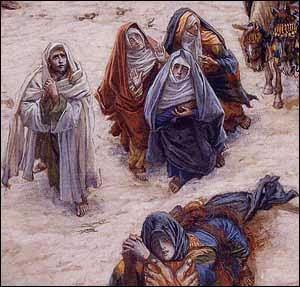
Today's Ash Wednesday, a day in which some Christian liturgical traditions limn crosses of ash on the foreheads of the faithful, to challenge them to remember that they are dust and will return to dust. Ash Wednesday inaugurates a liturgical season of remembering the cross and resurrection of Jesus, the central symbols on which Christian faith turns.
Yesterday, I noted that black womanist theologians like Delores Williams read the symbol of the cross differently than classic Christian theology has tended to do. I noted, in particular, the serious problems that black womanist theologians find in the substitutionary or surrogate understanding of the cross, with its strong emphasis on the obedience of a son to a father who commands the son's suffering as an act of love to redeem the world. Surrogacy of this sort has a quite different ring to the ears of women of color, Delores Williams argues, than it appears to have had for the male theological traditions that developed the substitutionary theory of the atonement.
Today, I'd like to point to another witness to the decisively different ways in which women theologians are now appropriating the symbol of the cross. Here's Latin American feminist theologian Ivone Gebara in her book Out of the Depths: Women’s Experience of Evil and Salvation, trans. and intro. Ann Patrick Ware (Minneapolis: Fortress, 2002)--three interlocking meditations on the meaning of the cross:
His cross does not stand alone; the surrounding community shouts "no" to this assassination, "no" to this crucifixion, "no: to the powers that kill. Women stand around his cross as his friends, caring for his lifeless body so that life will not be further violated (115).
Then:
We observe also that a certain reading of history, done with an emphasis on male heroes or martyrs, tends to overlook other agents in history, both men and women. It is once again a partial history with absolute claims. One recounted historical fact is universalized, one particular gesture is absolutized, and one person becomes the center of all activity. This reading of history exhibits a limited, narrow view of the complexity of historical events (118).
And finally:
One cross cannot contain all sufferings or all crosses. It would risk founding an empire of suffering, even if the end were to found the empire of love. Absolutizing the cross of Jesus is completely understandable in the context of the political theocentrism of the Middle Ages, but it has become problematic in our actual history (120).
Points to note in Gebara's analysis of the cross:
1. The cross is for her as a feminist theologian a communitarian symbol, not a solitary one. It would not be an exaggeration to say that, for Gebara, the community of Jesus's disciples--and, above all, the faithful women who followed him to the cross while almost all of his male disciples fled in fear--walked through the crucifixion process along with him.
2. Where much Christian iconography throughout history sees only Jesus and only the cross, Gebara reminds us that the gospels see others there standing along side him, especially faithful women who refuse to abandon him. They are the "surrounding community" who are equally important in the crucifixion drama--equally important along with Jesus and his cross.
3. They shout "no" to the crucifixion. They complicate all easy theories of the atonement and the cross that idolize the suffering of Jesus and read that obediential suffering as an uncomplicated and obvious act of love.
4. They also undercut the male cult of hero worship that has appropriated the symbol of the cross over and over again throughout the history of Christianity to glorify powerful men, heroes, martyrs, soldiers, conquerors carrying the cross of Christ as they subjugate others in the name of the cross.
5. As Gebara notes, many people make history. All people make history. The history of salvation is comprised of more people than Jesus on the cross. This exclusivist reading of the history of salvation has all too frequently been employed to ignore the salvific presence and salvific agency of women in salvation history.
6. And so, "One cross cannot contain all sufferings or all crosses." The cross of Jesus has frequently been used in Christian spirituality to obliterate, to minimize, to wipe out, the very real sufferings of many others who have suffered, too--in particular, of women, who have been treated, along with their suffering, as invisible when preachers of the gospel (predictably male) talk about suffering, redemption, Jesus, and his cross.
7. The absolutization of the cross of Christ to found an "empire of suffering" has gone hand in hand with the project of political theocentrism that has always been perfectly willing to subject despised others to endless suffering, in order to extend the domain of the church.
As I concluded yesterday when I looked at Delores Williams's black womanist theology of the cross, there is important hermeneutical power in reading our classic theological and biblical texts through the lens of those who have experienced historic oppression. There is is yet more light and truth to break out of God's word--when, that is, we can break that word out of the clutches of those who continue to insist that they and they alone own it, along with its light and truth. Because they happen to have been born male (and white and heterosexual) . . . .
The graphic is a detail from James Tissot's "Ce que voyait Notre-Seigneur sur la Croix" (1896-1894), at the Brooklyn Museum of Art.

